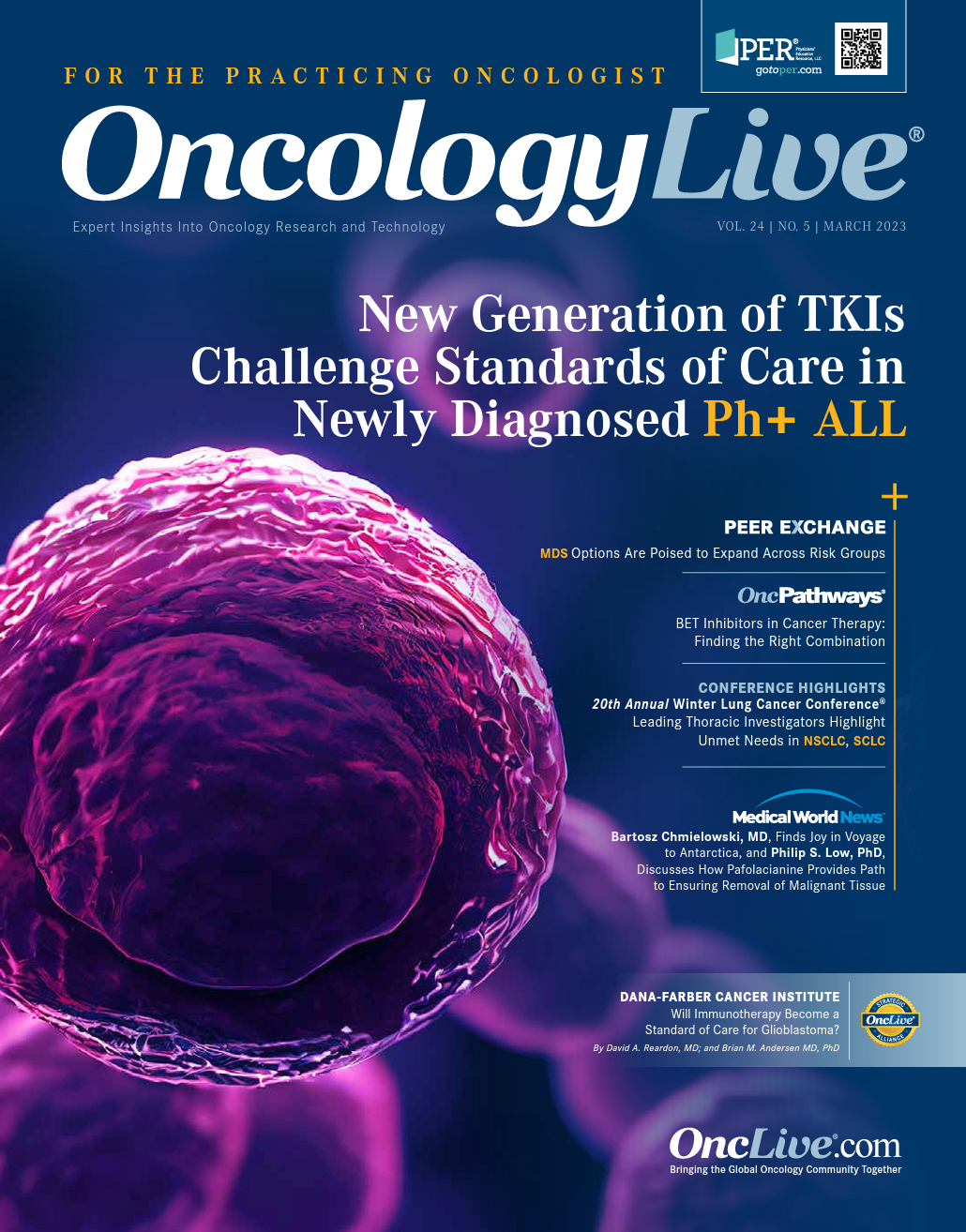Publication
Article
STELLAR-303 Aims to Carve Out Space for XL092 in mCRC Treatment Paradigm
Author(s):
Despite incremental advances in the treatment landscape of metastatic colorectal cancer, patients with the disease still face a poor prognosis.
J. Randolph Hecht, MD

Despite incremental advances in the treatment landscape of metastatic colorectal cancer (mCRC), patients with the disease still face a poor prognosis. The 5-year survival rate of approximately 14% underscores the need for more effective therapeutics in the space,1 but the recent emergence of XL092, a novel tyrosine kinase inhibitor (TKI), has sparked hope that the agent could become a key part of the mCRC treatment armamentarium.
“Most patients with mCRC will die from their disease; they [generally] don’t die from something else first,” J. Randolph Hecht, MD, director of the UCLA Gastrointestinal Oncology Program and a professor of clinical medicine at the David Geffen School of Medicine at UCLA in Los Angeles, California, told OncologyLive®. “Unfortunately, we have not moved the bar, really, in more than a decade. Fluorouracil was synthesized in the 1950s and was approved in 1962. Oxaliplatin and irinotecan come from the late 1990s. VEGF inhibitors are from the early 2000s, [followed by] EGFR [inhibitors]. We have had minor improvements since that time. Regorafenib [Stivarga] has some modest benefit. [There is also] trifluridine/tipiracil; there was just recently a phase 3 trial showing some modest benefit adding bevacizumab [Avastin] to that, but we’re talking benefits in months.”
XL092 has multiple targets, including MET, VEGFR2, and TAM kinases, which have been shown to stimulate tumor growth, metastasis, angiogenesis, and immune suppression of the tumor microenvironment.2 The agent was also engineered to have a short half-life of approximately 21 hours, which enables it to be administered via daily dosing and adds to its manageable tolerability profile. Additionally, previous phase 1/2 trials have shown that VEGFR2 TKIs can be effective in mCRC that is not microsatellite instability high (MSI-H) or mismatch repair deficient (dMMR) when combined with immune checkpoint inhibitors.2
XL092 Shows Promise in Early-Phase Study
Building off preclinical findings, XL092 has displayed preliminary efficacy with a manageable safety profile, both as a monotherapy and in combination with the immune checkpoint inhibitor atezolizumab (Tecentriq) targeting PD-L1 in patients with advanced solid tumors in the ongoing phase 1 STELLAR-001 trial (NCT03845166).3
STELLAR-001 is a dose-escalation and expansion study that is enrolling adult patients with an ECOG performance status of 1 or 0. As of June 13, 2022, 47 patients have been treated with XL092 monotherapy and 40 have received the combination regimen.
In the monotherapy cohort, daily oral XL092 was given at doses of 10 mg (n = 3), 20 mg (n = 7), 40 mg (n = 6), 80 mg (n = 5), 100 mg (n = 5), 120 mg (n = 14), and 140 mg (n = 7). Doses at the 10-mg and 20-mg levels were administered in powder form, and all higher doses were via tablet.3
In the combination arm, patients were treated with XL092 40 mg (n = 3), 80 mg (n = 16), 100 mg (n = 14), and 120 mg (n = 7), via daily oral administration. Atezolizumab 1200 mg was given intravenously every 3 weeks.
The dose-limiting toxicity (DLT) evaluation period was days 1 through 28 for the monotherapy cohort and days 1 through 21 for the combination cohort. In the monotherapy arm, safety was assessed on day 1 of the first 4 weeks, with additional assessments on day 2 of week 1, day 7 of week 4, day 1 of week 6, day 1 of week 9, and then every 4 weeks thereafter. In the combination arm, safety was assessed on day 1 of the first 4 weeks, with additional assessments on day 2 of week 2, day 7 of week 3, and then every 3 weeks thereafter.3
Patients had a median age of 61 years (range, 19-79) and 59 years (range, 24-82) in the monotherapy and combination arms, respectively. Most patients in both arms were White (81% and 73%, respectively), had an ECOG performance status of 1 (62% and 55%), and had previously undergone at least 3 lines of systemic anticancer therapy (68% and 68%). Three patients in the monotherapy arm had a diagnosis of CRC, compared with 7 in the combination arm.
The primary end point was to determine the maximum-tolerated dose (MTD) and/or the recommended dose of XL092 alone and in combination with atezolizumab. Secondary end points included assessing safety, tolerability, and plasma pharmacokinetics. Overall response rate (ORR) per RECIST 1.1 and other efficacy measures served as exploratory end points.3
Safety findings from the trial showed that at a median follow-up of 17.9 months (range, 4.6-38.8), 20 patients in the monotherapy arm experienced dose reductions of XL092 and 9 patients discontinued treatment with the agent due to treatment-emergent adverse effects (TEAEs). Treatment-related adverse effects (TRAEs) led to discontinuation in 7 patients. DLTs were observed in 2 patients, and 14 remained on study treatment at the data cutoff.
In the combination arm, at a median follow-up of 6 months (range, 0.2-20.0), TEAEs leading to dose reductions of XL092 were observed in 9 patients. Eight patients discontinued treatment due to TEAEs, and 3 patients discontinued treatment due to TRAEs. Atezolizumab was discontinued due to TEAEs and TRAEs in 7 and 3 patients, respectively. DLTs were present in 3 patients.3
The 2 DLTs in the monotherapy arm both occurred at the 140-mg dose level (grade 3 hypertension and grade 3 diarrhea). In the combination arm, DLTs were present at 3 different dose levels: 80 mg (grade 2 fatigue), 100 mg (grade 3 gastritis), and 120 mg (grade 3 abdominal pain). No grade 5 TRAEs were reported in either arm.
All patients in the monotherapy arm experienced an any grade TEAE, including nausea (51%), hypertension (45%), diarrhea (43%), and fatigue (36%). Grade 3/4 TEAEs were reported in 60% of patients and included hypertension (19%), diarrhea (9%), fatigue (6%), and vomiting (2%).3
Similarly in the combination arm, nearly all patients (98%) experienced a TEAE of any grade, including fatigue (63%), diarrhea (48%), decreased appetite (43%), and hypertension (25%). Grade 3/4 TEAEs occurred in fewer patients compared with the monotherapy arm (38% vs 60%), and included hypertension (13%), thrombocytopenia (5%), and abdominal pain (5%).3
Preliminary efficacy findings showed that XL092 displayed antitumor activity as both monotherapy and as a component of the combination. Overall, the ORRs were 10% (95% CI, 2.7%-23.1%) and 4% (95% CI, 0.1%-19.0%), respectively. Moreover, the disease control rates were 90% (95% CI, 76.9%-97.3%) and 74% (95% CI, 53.7%-88.9%), respectively. Tumor reduction was observed in 71% and 56% of patients, respectively.
“XL092 in combination with PD-L1 pathway inhibitors showed the patients actually had responses [even though] we would expect not to see any responses or very small number of responses,” Hecht said. “Now there are lots of potential reasons for this, [one of which] may be what they’re inhibiting. All those [kinases] have to do with immunosuppression. That’s the theoretical reason for this.”
Investigators determined the MTD of XL092 to be 120 mg and the recommended dose to be 100 mg for the agent both as monotherapy and in combination with atezolizumab. The 100-mg dose was chosen based on the manageable toxicity profile, best overall response data, and plasma biomarker data suggesting a consistent peripheral pharmacodynamic effect.3
Pivotal STELLAR-303 Trial Looks to Validate Preliminary Findings
Following the positive preclinical and earlyphase findings displayed by XL092, investigators are initiating the phase 3, global, open-label STELLAR-303 trial (NCT05425940).4 Exelixis, the developer of XL092, cited promising outcomes observed with cabozantinib (Cabometyx) in combination with immunotherapies, such as atezolizumab in the phase 1b COSMIC-021 trial (NCT03170960), which supported the investigation.5,6 Among 31 patients with CRC in the multicohort study, the objective response rate was 10%, with a disease control rate of 71% and median duration of response of 7.6 months (95% CI, 4.2-not estimable). Further, the combination elicited a median progression- free survival (PFS) of 3.0 months (95% CI, 2.7-5.4) and a median overall survival (OS) of 14.0 months (95% CI, 5.5-16.7).6
RAS mutational status also was evaluated in the study as an exploratory end point, and 12 patients with RAS wild-type disease drove the outcomes. The ORR for those with RAS wildtype disease vs those without (n = 19) was 25% vs 0%, respectively. This advantage extended to PFS and OS outcomes. The median PFS was 5.8 months (95% CI, 2.8-11.0) vs 2.7 months (95% CI, 1.6-4.1), respectively, with a median OS of 16.7 months (95% CI, 8.4-NE) compared with 8.7 months (95% CI, 4.7-15.9), respectively.6
“These small molecules [TKIs] all block other kinases—sometimes they’re called multitargeted—and some of those kinases may actually have to do with immune suppression,” Hecht said. “There’s been a thought that perhaps combining these drugs together might finally kind of crack the code and get long-term responses, or even any responses at all, in this huge group of patients.”
STELLAR-303 has an estimated enrollment of approximately 600 adult patients with RAS wild-type or RAS-mutant mCRC. Investigators want to include approximately 400 patients with RAS wild-type disease and 200 patients with RAS-mutant disease. The trial will compare the safety and efficacy of XL092 in combination with atezolizumab with that of the multikinase inhibitor regorafenib.2,4
To be eligible for enrollment, patients must have measurable disease per RECIST 1.1 and an ECOG performance status of 1 or 0. Patients need to have experienced radiographic progression on, be refractory to, or be intolerant to standard-of-care therapy for mCRC. Additionally, progression must have occurred during treatment or within 3 months of receiving the most recent standard-of-care therapy. Patients with MSI-H/dMMR disease will be excluded.
After enrollment, patients will be randomly assigned 1:1 to receive either oral XL092 100 mg daily in combination with intravenous atezolizumab 1200 mg once every 3 weeks or oral regorafenib 160 mg daily for the first 21 days of each 28-day cycle (FIGURE).4 Patients will be stratified by geographic region (Asia vs other), RAS status (wild-type vs mutant), and the presence of liver metastases (yes vs no).
“In some of the early trials, there was a correlation between being RAS wild-type—that’s approximately 50% of colorectal cancers—and better response. STELLAR-303 builds on those trials,” Hecht said. Tumor assessment per RECIST 1.1 will be performed every 8 weeks through week 49, then once every 12 weeks thereafter. Patients will receive study treatment until intolerable toxicity or lack of clinical benefit is reported.
The primary end point is overall survival (OS) in the RAS wild-type population.2,4 Secondary end points include PFS, ORR, duration of response, OS, and safety. Recruitment for STELLAR-303 began in June 2022 and is ongoing.5 The study is estimated to be completed in February 2026.4
References
- Survival rates for colorectal cancer. American Cancer Society. Updated March 1, 2022. Accessed February 10, 2023. bit.ly/3jwaKZQ
- Hecht JR, Tabernero J, Parikh AR, et al. STELLAR-303: a phase 3 study of XL092 in combination with atezolizumab versus regorafenib in patients with previously treated metastatic colorectal cancer (mCRC). J Clin Oncol. 2023;41(suppl 4):TPS267. doi:10.1200/JCO.2023.41.4_suppl.TPS267
- Sharma MR, Subbiah V, Shapiro G, et al. A phase I first-in-human study of XL092 in patients (pts) with locally advanced or metastatic solid tumors: results from dose-escalation of XL092 alone and in combination with atezolizumab. Ann Oncol. 2022;33(suppl 7):S760. doi:10.1016/j.annonc.2022.07.609
- Study of XL092 + atezolizumab vs regorafenib in subjects with metastatic colorectal cancer (STELLAR-303). ClinicalTrials.gov. Updated January 6, 2023. Accessed February 10, 2023. https://www.clinicaltrials.gov/ct2/show/NCT05425940
- Exelixis announces initiation of the STELLAR-303 phase 3 pivotal trial evaluating XL092 in patients with metastatic colorectal cancer. News release. Exelixis Inc. June 21, 2022. Accessed February 10, 2023. bit.ly/3XlJZ8i
- Abrams TA, Kazmi SMA, Winer IS, et al. A phase 1b multitumor cohort study of cabozantinib plus atezolizumab in advanced solid tumors (COSMIC-021): results of the colorectal cancer cohort. J Clin Oncol. 2022;40(suppl 4):121. doi:10.1200/JCO.2022.40.4_suppl.121










